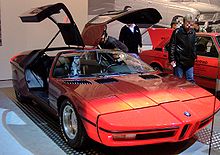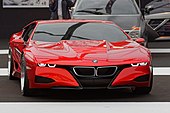BMW M1
| BMW | |
|---|---|
|
BMW M1 in the BMW Museum
|
|
| E26 | |
| Sales designation: | M1 |
| Production period: | 1978-1981 |
| Class : | Sports car |
| Body versions : | Coupe |
| Engines: |
Otto engine : 3.5 liters (204 kW) |
| Length: | 4359 mm |
| Width: | 1824 mm |
| Height: | 1138 mm |
| Wheelbase : | 2560 mm |
| Empty weight : | 1300 kg |
The BMW M1 (internal designation E26 ) was a super sports car from BMW with a longitudinal mid-engine and rear-wheel drive . From autumn 1978 to the end of 1981, 460 vehicles were produced.
history
In 1972 BMW presented a prototype called BMW Turbo (E25) . This vehicle, equipped with gullwing doors and a four-cylinder mid- engine, was never intended for production, but served as a design study and technology carrier. Another copy followed in 1973. The 250 km / h turbo was the answer to the clumsy prototypes on the subject of safety cars with bulky attachments.
The basic concept of the turbo creates a thick safety cushion for the driver: low center of gravity, wide contact area and a special chassis. There were also driver assistance systems such as ABS , radar distance warning systems and a lateral accelerometer. In addition, there was a passive safety package with seat belts that close the electrical circuit for the ignition lock, or the safety steering column with three universal joints. The door posts continued into the roof formed an invisible roll cage and were supplemented by safety crumple zones with hydraulic dampers in the front and rear. Safety was also in the foreground when it came to the color scheme: a bright red with a bright orange front and rear.
The futuristic styling study by BMW chief designer Paul Bracq set the direction for the development of the BMW M1 that followed in 1976. This ran according to BMW specifications at Lamborghini in Sant'Agata Bolognese , Italy . The vehicle was originally supposed to be manufactured there, but later there were problems at Lamborghini, so the vehicle was manufactured by Baur in Stuttgart. Giorgio Giugiaro was responsible for the design of the body , who made the BMW M1 more objective than the BMW Turbo prototype and dispensed with the gullwing doors.
The BMW M1 was presented in 1978 and classified as a superlative car. The car tester Gerold Lingnau certified the car as having “sophisticated technology and superior driving characteristics”. BMW founded BMW Motorsport GmbH specifically for development and production, so the M in the model name stands for motorsport . In 1979 the car cost 113,000 German marks , making it the most expensive German car.
Body and technology
The body of the BMW M1 is built on a tubular space frame. Many parts from the BMW range of cars at the time are used. An externally striking feature are the rear lights used from the BMW 6 series at the time . The use of pop-up headlights , which were necessary for the aerodynamically flat front due to the American regulations on lamp height at the time, was unusual for BMW .
Engines
BMW turbo study:
- In-line engine with four cylinders, two valves per cylinder, 2.0 liter displacement , mechanical Kugelfischer injection system with central throttle valve and turbocharging, 200 to 280 hp depending on the boost pressure , engine designation BMW M10 , base engine for the BMW 2002 turbo, which was produced in series from 1973 ( there 170 hp).
BMW M1 production version:
- In-line engine with six cylinders , four valves per cylinder, 3.5 liter displacement, mechanical Kugelfischer injection system with individual throttle valves, 204 kW / 277 hp at 6600 rpm, 330 Nm at 5000 rpm (street version), engine designation M88 , basic engine for the with equipped with electronic injection and in 1983 presented the M 635 CSi and later the BMW M5 (E28) .
BMW M1 racing version:
- In-line engines with six cylinders, four valves per cylinder, mechanical Kugelfischer injection system and an output of 345 kW / 470 PS as a naturally aspirated engine with flat slide system, up to 626 kW / 850 PS with turbocharging .
BMW M88 engine with Kugelfischer injection , PL06 injection pump and single throttle system from a series BMW M1
Performance
The road version of the BMW M1 accelerates from 0 to 100 km / h in around 5.6 seconds and reaches a top speed of 262 km / h. The Group 4 vehicle accelerates to 100 km / h in 4.5 seconds and reaches a top speed of 310 km / h. Until the sales of the Porsche 911 turbo with factory performance upgrade began in 1983, the BMW M1 was the fastest production sports car from a German manufacturer. Measured values from the magazine auto motor und sport :
- 0–100 km / h 6.0 s
- 0–120 km / h 8.3 s
- 0–140 km / h 10.5 s
- 0–160 km / h 13.1 s
- 0–180 km / h 17.5 s
- 0-200 km / h 21.8 s
- 1 km, standing start: 25.4 s
- Top speed: 265 km / h
Motorsport

Originally the BMW M1 was planned for use in motorsport, only one homologation series was to be built in small numbers for public road traffic. However, due to changes in the international regulations before the presentation of the BMW M1, it proved to be practically superfluous as a racing car. Although it was still used with moderate success as a racing car in various series, the majority of the vehicles produced, contrary to the original plan, were sold to private individuals as a street version.
Only in the Procar series , a supporting program of Formula 1 in 1979 and 1980, did the BMW M1 gain greater attention in the field of racing. In the Procar series, the five fastest Formula 1 drivers from the training runs with works vehicles of the BMW M1 competed against selected private drivers of this vehicle type.
M1 homage
To mark the 30th anniversary of the BMW M1, BMW presented the M1 Hommage study in April 2008 . According to official voices from the BMW Group, it should be a one-time design study that will not go into production. The vehicle was shown at the Dubai International Motor Show and the Melbourne International Motor Show in 2009, at the Retromobile in Paris in 2013, at the automobile international festival in 2015 and at the Concorso d'Eleganza on Lake Como in 2016.
literature
- 30 years of the BMW M1 . In: BMW Group Classic (Ed.): BMW Classic live . M1 special. 2008 ( [1] - BMW Group Archive - Search - BMW Classic live).
- Max Bauer: BMW M1 - a career of its own . In: BMW Group Classic (Ed.): BMW Classic live . No. 1 , 2008, p. 42–47 ( bmw-konzernarchiv.de - BMW Group Archive - Search - BMW Classic live).
- Robert Weber: Cars in Detail - BMW M1 . In: powerslide - historical motorsport . Special issue 40 years of BMW M Power. Petrolpics, September 2012, ISSN 2190-0701 , p. 46-54 .
- Jochen Neerpasch, Jürgen Lewandowski: BMW Profiles . 1st edition. tape 10 : BMW M1 - The Story . Delius Klasing, Bielefeld 2008, ISBN 978-3-7688-2512-2 .
- Lothar Boschen: BMW M1 (= cars that made history ). Motorbuch-Verlag, Stuttgart 1989, ISBN 3-613-01265-0 .
Web links
- The BMW M1 - sports car with a profile. BMW TV. bmw.de, accessed on June 27, 2013 .
- Jörg Reichle: BMW M1 - The cool icon. sueddeutsche.de, May 11, 2010, accessed on June 14, 2013 .
References and comments
- ^ BMW Group newspaper . No. 9 , 2006.
- ↑ a b Frank Gotta: Paris Motor Show: Some new things in the West - BMW presents the M1 . In: Frankfurter Allgemeine Zeitung . October 11, 1978, p. 33 .
- ↑ Gerold Lingnau: The BMW M1: Sports car tamed for everyday use - the 100,000-mark car offers top-class driving performance . In: Frankfurter Allgemeine Zeitung . May 2, 1979, p. IV .
- ↑ Corresponds to around 131,000 euros in today's currency, adjusted for purchasing power. The figure was based on the template: Inflation determined, rounded to 100 EUR and applies to the past January.
- ↑ Andreas Gabriel (Ed.): Porsche 911 Turbo - Air Cooled Years 1975–1998 . 1st edition. BMB, Berlin Motor Books, Berlin 2012, ISBN 978-3-9814592-1-0 .
- ↑ The BMW sports collection . In: Auto, Motor und Sport . No. December 25 , 1986.
- ^ Moritz: BMW M1 “Homage”! automobil-blog.de, April 27, 2008, accessed June 14, 2013 .
- ↑ Thomas Geiger: Dubai Motorshow - Gold rush in the supermarket of luxury sleds . In: The world . December 16, 2009 ( welt.de [accessed June 14, 2013]).
| Timeline of the glass series models from 1955 to 1969 | |||||||||||||||||||||
|---|---|---|---|---|---|---|---|---|---|---|---|---|---|---|---|---|---|---|---|---|---|
| Type | independent (Hans Glas GmbH) | BMW | |||||||||||||||||||
| 1950s | 1960s | 1970s | |||||||||||||||||||
| 5 | 6th | 7th | 8th | 9 | 0 | 1 | 2 | 3 | 4th | 5 | 6th | 7th | 8th | 9 | 0 | 1 | 2 | 3 | 4th | ||
| Microcar | Goggomobil T | ||||||||||||||||||||
| Small car | Isar ("large Goggomobil") | ||||||||||||||||||||
| Lower middle class | 1004, 1204, 1304 | ||||||||||||||||||||
| Middle class | 1700 | 1800 SA, 2000 SA / 1804, 2004 [1] | |||||||||||||||||||
| Coupe | Goggomobil TS | ||||||||||||||||||||
| 1300 GT, 1700 GT | 1600 GT [2] | ||||||||||||||||||||
| 2600 V8, 3000 V8 | 3000 V8 [3] | ||||||||||||||||||||
| Vans | Goggomobil TL | ||||||||||||||||||||
|
|
|||||||||||||||||||||













